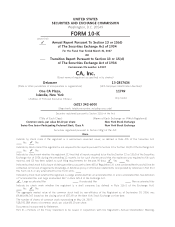Computer Associates 2007 Annual Report Download - page 21
Download and view the complete annual report
Please find page 21 of the 2007 Computer Associates annual report below. You can navigate through the pages in the report by either clicking on the pages listed below, or by using the keyword search tool below to find specific information within the annual report.extent and duration of protection given to different types of intellectual property rights vary under different countries’ legal
systems. Generally, our U.S. and foreign patents expire at various times over the next twenty years. While the durations of our
patents vary, we believe that the durations of our patents are adequate. The expiration of any of our patents will not have a
material adverse effect on our business. In some countries, full-scale intellectual property protection for our products and
technology may be unavailable, or the laws of other jurisdictions may not protect our proprietary technology rights to the
same extent as the laws of the United States. We also maintain contractual restrictions in our agreements with customers,
employees and others to protect our intellectual property rights. In addition, we occasionally license software and technology
from third parties, including some competitors, and incorporate them into our own software products.
The source code for our products is protected both as trade secrets and as copyrighted works. Some of our customers are
beneficiaries of a source code escrow arrangement that enables the customer to obtain a contingent, future-limited right to
access our source code. If our source code is accessed, the likelihood of misappropriation or other misuse of our intellectual
property may increase.
We are not aware that our products or technologies infringe on the proprietary rights of third parties. Third parties, however,
may assert infringement claims against us with respect to our products, and any such assertion may require us to enter into
royalty arrangements or result in costly and time-consuming litigation. Although we have a number of U.S. and foreign patents
and pending applications that may have value to various aspects of our products and technology, we are not aware of any
single patent that is essential to us or to any of our principal business product areas.
We continue to invest extensively in product development and enhancements. We anticipate that we will continue to adapt
our software products to the rapid changes in the IT industry and will continue to enhance our products to help them remain
compatible with hardware changes.We expect that we will continue to be able to improve our software products to work with
the latest hardware platforms and operating systems.
To keep CA on top of major technological advances and to ensure our products continue to work well with those of other
vendors, CA is active in most major standards organizations and takes the lead in many. Further, CA was the first major
software company to earn the International Organization for Standardization’s (ISO) 9001:2000 Global Certification, the
ultimate ISO certification.
In addition, CA has built a strong global product development staff in Australia, China, the Czech Republic, Germany, India,
Israel, Japan, the United Kingdom and the United States. Our technological efforts around the world ensure we maintain a
global perspective of customer needs while cost-effectively tapping the skills and talents of developers worldwide, and enable
us to efficiently and effectively deliver support to CA customers.
In the United States, product development is primarily performed at our facilities in Brisbane and Redwood City, California;
San Diego, California; Lisle, Illinois; Framingham, Massachusetts; Mount Laurel, New Jersey; Islandia, New York; Plano, Texas;
and Herndon, Virginia.
For the fiscal years ended March 31, 2007, 2006 and 2005, the costs of product development and enhancements, including
related support, charged to operations were $0.7 billion for each fiscal year. In fiscal years 2007, 2006 and 2005, we
capitalized costs of $85 million, $84 million, and $70 million, respectively, for internally developed software. The increase in
capitalized costs for fiscal years 2007 and 2006 as compared with fiscal year 2005 was principally related to the effort to
refresh our product offerings, including Enterprise Systems Management (Unicenter r11) and BrightStor products.
Customers
No individual customer accounted for a material portion of our revenue during any of the past three fiscal years, or a material
portion of the license contract value that has not yet been earned (deferred subscription value) reported at the end of any
period in the past three fiscal years. At March 31, 2007, five customers accounted for substantially all of our outstanding prior
business model net receivables which amounted to approximately $503 million, including one large IToutsourcing customer
with a license arrangement that extends through fiscal year 2012 with a net unbilled receivable balance in excess of
$400 million.The majority of our software products are used with relatively expensive computer hardware. As a result, most of
our revenue is generated from customers who have the ability to make substantial commitments to software and hardware
9
























